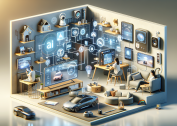Curious about artificial intelligence and its growing impact? This guide explores how AI influences daily life, job markets, science, ethics, and the global economy, revealing what’s changing, what’s next, and why artificial intelligence keeps making headlines.
AI Is Everywhere: From Smart Homes to Healthcare
Artificial intelligence, or AI, is no longer just a buzzword in the tech world. It’s an active force in homes, hospitals, and businesses, often working quietly behind the scenes. For example, smart home assistants respond to voice commands, thermostats anticipate temperature preferences, and streaming platforms suggest what to watch next using AI-powered algorithms. People rely on AI to manage their schedules, shop online, and even create music playlists tailored to personal taste. The reach of this technology keeps expanding.
Healthcare is watching a transformation driven by artificial intelligence. Diagnostic tools powered by machine learning analyze X-rays, MRIs, and lab results in seconds. These systems sometimes catch subtle clues—even those that elude experienced doctors. Virtual health assistants answer questions about symptoms or medication—no appointment required. Some hospitals even deploy AI robots to deliver supplies, perform physical tasks, and keep things running smoothly. This integration aims to support clinicians and improves healthcare efficiency, with continued research unlocking more possibilities (https://www.nih.gov/research-training/medical-research-initiatives/bridge2ai/artificial-intelligence).
Beyond personal life and healthcare, artificial intelligence is shaping other industries at an unprecedented pace. For instance, self-driving cars use AI to interpret sensor data and make split-second decisions. Customer service bots answer questions in seconds, and manufacturers depend on robotics for speed and quality. Even agriculture benefits—AI analyzes satellite data, helping farmers optimize crop yields. Wherever computers analyze huge datasets and make predictions, that’s usually AI at work. This broad adoption shows how artificial intelligence is woven into daily routines, even when it’s invisible.
Machine Learning and Data: The Brains Behind the Tech
At the core of artificial intelligence lies machine learning. This technique lets computers learn from massive amounts of data, forming patterns, and making decisions—often faster than a human could. For example, when a search engine ‘guesses’ what you’re looking for, it’s using algorithms trained on billions of search terms, websites, and user behavior cues. The same thing happens when photo apps recognize faces or sort images by location. Machine learning thrives on raw data and the never-ending flow of new information keeps AI getting sharper.
Data is sometimes called the ‘new oil’ because of its value in fueling artificial intelligence development. As more data is collected—through personal devices, public records, or social platforms—AI models grow increasingly powerful. Businesses collect, store, and process data to predict trends, improve products, and make smarter decisions. However, the scale and speed of this data-driven revolution raise important questions about privacy and digital trust. Governments and organizations are working to balance innovation with responsible use, a topic that grows more urgent every year (https://www.nist.gov/artificial-intelligence).
But not all data is created equal. High-quality, unbiased data is essential for training reliable AI models. If the data reflects prejudices or errors, the resulting algorithms may inherit those flaws, too. Scientists and engineers carefully curate data and monitor outcomes, aiming for fairer, more accurate results. Many research universities now offer courses or certifications focused on ethical data handling in artificial intelligence, supporting a new generation of trustworthy digital leaders. As more people depend on AI for daily decisions, these efforts are critical for long-term public confidence in the technology.
The Job Market Is Adapting to AI’s Rapid Growth
Job landscapes are shifting in response to rapid artificial intelligence progress. Some traditional positions have already changed, while other entirely new roles have emerged. For instance, analysts predict continued growth in fields like data science, machine learning, and cybersecurity. Technical workers specializing in AI commands high salaries, while others are learning to integrate AI tools into their day-to-day work. Contrary to popular belief, new AI technology doesn’t always eliminate jobs—it can enhance skill sets and create opportunities in areas like digital health or smart logistics.
The rise of automation in industries like finance, logistics, and manufacturing is a prime example of artificial intelligence at work. Machines can now handle repetitive tasks with greater accuracy and speed, freeing up skilled professionals to focus on creative, strategic, or supervisory duties. Online training platforms and universities are responding to this demand by offering up-to-date AI and automation courses. Some employers even sponsor ‘reskilling’ programs so current employees can stay competitive in a rapidly evolving economy. Adaptation is becoming the new normal (https://digital-strategy.ec.europa.eu/en/library/european-approach-artificial-intelligence).
Social impacts of artificial intelligence extend to democracy, safety, and equality. AI-enabled systems make decisions about jobs, insurance, credit, or even parole recommendations in some countries. Unchecked, these decisions can unfairly impact groups or reinforce stereotypes. Transparency and accountability are essential, so many experts call for ‘explainable AI’—technology that reveals, in clear language, how it reaches conclusions. Education and access also matter: when more people understand how AI works, society benefits from greater inclusion, participation, and trust in digital systems.
Another layer of ethical debate revolves around autonomous weapons and surveillance technologies. Nations and international bodies debate rules about using AI in defense or policing. Meanwhile, social platforms face scrutiny over algorithmic influence on news, advertising, and elections. Solutions are complex, but ongoing research, public discussion, and collaboration will help societies shape technology responsibly. These conversations are not just philosophical—they shape the practical policies governing the next wave of innovation.
AI and the Future of Science and Research
Artificial intelligence isn’t just transforming industries—it plays a game-changing role in science and research. AI analyzes immense datasets in genomics, climate modeling, particle physics, and astronomy, where no human team could possibly keep up. It uncovers new patterns in DNA, helps design molecules for potential drugs, and even predicts how climate shifts might affect different regions. Researchers now rely on AI tools to speed up discovery, test hypotheses, and reduce costly errors. Many scientific breakthroughs have roots in data intelligence that only computers can supply.
Collaborative research projects highlight the best of artificial intelligence in action. For example, during public health emergencies, AI models predict disease spread, suggest potential treatments, and manage health resources efficiently. Some projects use AI to track wildlife, monitor pollution, or identify illegal fishing activities from space. The intersection of AI and citizen science means anyone with a smartphone or sensor can contribute valuable data, broadening the reach and relevance of research efforts. This connection between AI and science inspires hope for solving global challenges (https://www.nature.com/articles/s42256-018-0007-3).
Of course, the scientific community is actively considering the risks of relying on artificial intelligence. Researchers work to avoid bias, overfitting, or incorrect predictions. Leading universities offer open-access AI datasets and host contests to improve research transparency and peer review. These initiatives create healthier competition, spark more inclusive research networks, and improve results. The role of artificial intelligence in scientific discovery seems certain to expand, with vigilance and creativity guiding the next wave of breakthrough tools.
What the Global AI Race Means for Everyday Life
The global race to lead in artificial intelligence innovation brings real-world consequences. Nations invest billions in AI research and development, hoping to gain advantages in industry, defense, and education. This competition can spur amazing breakthroughs—think advanced translation tools or real-time medical diagnostics. At the same time, it raises questions about security and equal access. Who gets to shape the future of this technology?
Some governments create national AI strategies to support research, ethical guidelines, and public understanding. For instance, Canada, Japan, and China all place big bets on AI education to ensure citizens are prepared for shifts in the economy. These strategies address the digital divide by investing in connectivity, teacher training, and equitable access to online resources. Creating partnerships between universities, businesses, and governments can build a robust, responsible AI ecosystem (https://www.oecd.org/going-digital/ai/principles/).
Everyday people play a growing role, too. New tools make it easier to use or experiment with artificial intelligence, democratizing access to powerful technologies once reserved for large corporations or labs. AI-powered translation, reading aids, accessibility features, and smart apps help break down social or language barriers. By understanding the basics of artificial intelligence—and how it affects society—readers can prepare for a world where AI is as common as email or smartphones are today. Curiosity fuels adaptation, making the digital future a little more accessible to everyone.
References
1. National Institutes of Health. (n.d.). Artificial Intelligence. Retrieved from https://www.nih.gov/research-training/medical-research-initiatives/bridge2ai/artificial-intelligence
2. National Institute of Standards and Technology. (n.d.). Artificial Intelligence. Retrieved from https://www.nist.gov/artificial-intelligence
3. Brookings Institution. (n.d.). The Potential and Limits of Artificial Intelligence. Retrieved from https://www.brookings.edu/articles/the-potential-and-limits-of-artificial-intelligence/
4. European Commission. (n.d.). European Approach to Artificial Intelligence. Retrieved from https://digital-strategy.ec.europa.eu/en/library/european-approach-artificial-intelligence
5. Nature Machine Intelligence. (2019). Artificial Intelligence in Science. Retrieved from https://www.nature.com/articles/s42256-018-0007-3
6. Organisation for Economic Co-operation and Development. (n.d.). OECD Principles on Artificial Intelligence. Retrieved from https://www.oecd.org/going-digital/ai/principles/









